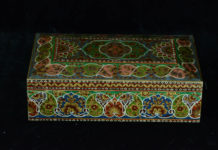The coastline of Kerala extends over five hundred and eighty kilometers. An internal network of forty-four rivers and innumerable backwater canals boats have been the transportation of choice for everyday life and work. Ancient maritime history is recorded in Sumerian texts that date the spice trade of this region to the third millennia BCE. The crafting of ships and boats for commerce, transportation, leisure and other purposes remains an indispensable craft.
Locally called vallam, a variety of boats continue to be constructed following ancient precepts and techniques. Among them is the traditional war boat of Kerala, the chundan vallam or snake-boat. Legend has it that in the feudal battles of the fourteenth century, King Devanarayana of Chembakassery faced with defeat fought back by arming his navy with a newly developed fleet of swift war boats—the chundan vallam. These powerful traditional speed boats are now crafted in their new avatar as race boats. With the bowsprit shaped like a hooded snake and the stern of the boat elevated, its flexibility and suppleness is reminiscent of a snake cutting through water. Built in lengths of up to 138 feet, with a height of about 20 feet, they can hold over a hundred oarsmen. The rhythm and synchronicity of the pickup and accelerating strokes is directed by a lead singer who stands in the middle of the boat reciting the vanchipattu, the rhythmic song that sets the oarsmen’s pace as they row in perfect unison.
Usually built in the durable wood of the wild jackfruit (anjili /artocarpus hirsutus), professional boat makers follow oral traditions in their construction. The making of the snake boat is a closely guarded secret as each village competes in the boat races (the Vallam Kali), striving to outdo the other in crafting the lighter, stronger and swifter boat. The most coveted win is the Nehru Trophy Cup. To meet the increasing costs of constructing a chundan vallam, private clubs and organizations sponsor the making, thus keeping the tradition alive.




